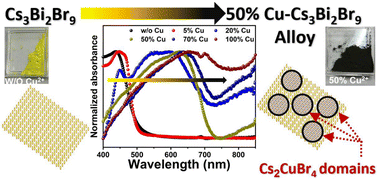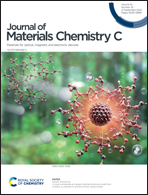Structure modulation for bandgap engineered vacancy-ordered Cs3Bi2Br9 perovskite structures through copper alloying†
Abstract
Lead-free, vacancy-ordered, Cs3Bi2Br9 perovskite is considered promising inorganic, stable, and non-toxic halide perovskite for optoelectronic and photovoltaic applications. However, its wide bandgap limits its state-of-art applications. We notice an observable enhancement of light absorption of Cs3Bi2Br9 perovskite crystals upon CuBr2 addition to the perovskite precursor. X-ray diffraction, 133Cs solid state NMR, Raman spectroscopy, X-ray photoelectron spectroscopy, and density functional theory calculations were studied to find out the nature of the perovskite crystal formation mechanism. With the addition of up to 50% CuBr2, the Cs3Bi2Br9 perovskite retains its matrix structure with homogeneously distributed Cs2CuBr4 large domains. Drop-casting of perovskite/DMSO solutions over TiO2 thin films reveals a reduction of the direct bandgap from 2.56 eV for pristine Cs3Bi2Br9 to 1.77 eV for a 50% Cu2+ alloyed one. First-principles calculations reveal the possibility of Cs2CuBr4 phase formation with higher Cu alloying, which can be the main reason behind bandgap narrowing. For homogeneously Cu alloyed Cs3Bi2Br9, reduction of the effective bandgap can occur due to the formation of compensating defect levels (VBr, CuBr) above the pristine valence band maxima (VBM). These results highlight the importance of alloying for structure modulation for bandgap engineered vacancy-ordered perovskite structures.



 Please wait while we load your content...
Please wait while we load your content...